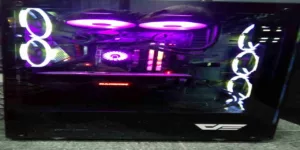One of the ways I’ve been dealing with (or hiding from) the lack of certified election results in the US this year is building new desktop PCs for myself and my wife. I currently use a Threadripper workstation as my primary system, and when I got it earlier this year, it pretty much blew anything else I’ve tested out of the water.
So, as therapy, I built two new systems, one using the AMD Ryzen 9 5900 processor and parts I had sitting around, and another using their even faster 5950 processor and current high-performance parts. Then I benchmarked everything and, holy crap, not only was it a lot cheaper than I thought it would be to use the high-performance parts but man, were they ever worth it.
Let’s walk through my experience this week.
Threadripper
Let’s start with my Threadripper system. Falcon built it, and they did an impressive job. It worked right out of the box, I had no driver issues, and within minutes of unboxing it, I was up and running and playing my favorite game “Ashes Of The Singularity”.
The best benchmark, it turns out, is Geekbench’s multi-processor score, and it was a whopping 127,631. If you have 32 cores, you are going to light that benchmark up.
This configuration uses the 3970X Threadripper and the Radeon RX 5700 XT Graphics card, and 64 GB of memory. This PC is a real workstation similar to what the Falcon Northwest site prices out around $5K, so it is no cheap date.
Benchmarks:
PCMark 10 6,173 total, Essentials 9,270, Productivity 6,983 Digital Content 10,831
3DMark 9,065 total Graphics 8,719 CPU 11,702
Geekbench 5,439 Single-Core 127,631 Multi-Core
So really not that shabby, but now lets go my “budget” off the shelf parts system.
5900 System
In this system build, I used an older Radeon R9 390 card, the Ryzen 9 9500 processor, an old SSD drive I had sitting around (Samsung), Thermaltake 3,000 MHz memory, and an old power supply I had from another project. So figure $550 for the processor, $100 for the case, $100 for the memory, $171 for the motherboard (MSI Arsenal Gaming), and around $100 for the power supply. So around $1,200 with extras.
The scores were pretty impressive.
Benchmarks:
PCMark 10 was 7,281 Essentials 10,588 Digital Content 9,525
3DMark was 4,446 Graphics 4,005, and CPU was 11,850 (I took a big hit with that older graphics card)
Geekbench was 6,372 Single Core and 58,993 multi-core
The graphics card under-performed the newer card in the Threadripper. Except for that massive multi-core score on Geekbench, the processor did impressively well against the far more expensive Threadripper part. (Be aware that most photo and movie editors would run much faster on Threadripper).
5950 System
For this system, I got the best of everything and new, so I got the Gigabyte Aorus Master X570 motherboard $359, WD Black SN750 M.2 SSD $62.99, Thermaltake 4600 MHz memory, Deep cool cooler $80, Phantom black ATX Mid-Tower case $79, and Gamemax 850W $139, the Ryzen 9 5950X for $799, and the Radeon 6800XT card for $649. The total comes to $2,167.99 or about twice what I spent on the 5900 system. However, the benchmarks were impressive.
Benchmarks:
PCMark 10 8,503 Essentials 11,460 Productivity 9,662 Digital Content Creation 15,068
3DMark 16,576 Graphics 17,720 CPU 12,139
Geekbench Single-core 6,358 Multi-Core 71,061
Wrapping Up:
For the faster memory and the better M.2, the delta in price was around $160 and worth it. The extra $250 for the 5950 wasn’t worth it for what turned out to be a slight performance bump in the 3DMark and Geekbench scores. That makes the 5900 a huge bargain. The graphics card made the biggest difference, and that Radeon 6800, as others have pointed out, is an impressive part. The Deepcool water cooling part used two screws to attach the heat sync making it one of the easiest to put on and take off any water-cooled system I’ve yet used; the Phantom Black ATX Mid Tower case looks fabulous for the money (and it is straightforward to work with). I liked the MSI Gaming Plus X570 motherboard better than the Gigabyte Aorus Master (largely because when I had a BIOS problem, it pointed me to the problem more quickly). It doesn’t have wireless Wi-Fi 6 on the board, but you can add it with a card for under $40. This all means that for around $1,800, I could build a system like the 5950 system above and probably blow the doors off most everything else close to that price out there on benchmarks.
But you know, the best part of building both AMD systems was I wasn’t watching the news, I wasn’t getting aggravated about the US election, and I wasn’t stressing out on the virus. Playing with the systems has been great but building them was proper therapy and that alone was worth the money. I mean, you can build the system safely at home and then use it to play the game to your heart’s content, all while staying safe from the damned virus.
One final thought is that damn; this isn’t your father’s AMD; these are impressive scores that rival full-on workstations. AMD kicked some butt this year!







